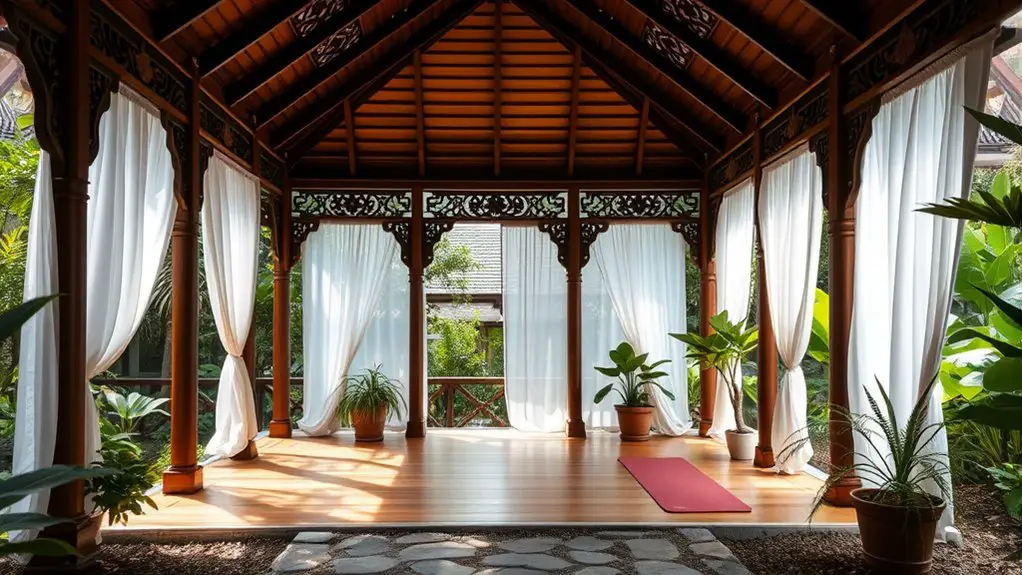To design a gazebo for yoga and meditation retreats, start by choosing an ideal location that captures sunlight while minimizing distractions. Select sustainable materials that blend aesthetics with durability. Embrace natural elements like plants and water features to foster tranquility. Guarantee comfort and accessibility with ergonomic seating and non-slip surfaces. Enhance the atmosphere with soft, ambient lighting and calming decor. You’ll discover more insights on creating a serene sanctuary that supports your practice.
Choosing the Ideal Location
When you’re choosing the ideal location for your yoga and meditation gazebo, consider how the space will harmonize with nature. Think about site orientation; positioning your gazebo to capture the morning sun can energize your practice, while dappled afternoon shade creates a serene vibe. Environmental factors, like nearby trees or water features, can enhance your experience, offering both beauty and tranquility. You’ll want to select a spot that minimizes distractions from noise or traffic, allowing you to feel free in your practice. Pay attention to wind patterns, too; a gentle breeze can cool you down while also connecting you to the natural world. Additionally, ensure that your chosen spot provides adequate airflow to maintain a comfortable environment during your sessions. Ultimately, the right location will nourish your spirit and deepen your connection to the environment.
Selecting the Right Materials
When it comes to selecting materials for your gazebo, you’ll want to weigh the benefits of natural versus synthetic options. Think about how each material stands up to weather conditions in your area; durability and sustainability are key. Choosing wisely not only enhances your space but also aligns with your values for a mindful practice. Additionally, considering the overall expenses related to materials, installation, and maintenance will help ensure your gazebo remains a cherished space for years to come.
Natural vs. Synthetic Materials
While choosing the right materials for your yoga and meditation gazebo, it’s essential to contemplate the balance between aesthetics, durability, and sustainability. Natural materials, like wood and bamboo, offer sustainability benefits, harmonizing with the environment while providing a warm, organic feel. They often boast impressive material longevity, standing the test of time if properly maintained. On the other hand, synthetic materials, like composite decking, can provide durability and resistance to wear, but may lack the charm of nature. Consider how each option aligns with your vision of freedom and tranquility. Embracing a combination of both can create a serene space that reflects your values while ensuring the gazebo remains a sanctuary for years to come.
Weather Resistance Considerations
Although you might envision your gazebo as a tranquil retreat, it’s essential to contemplate how it will withstand the elements. Choosing the right materials is vital for ensuring wind resistance and effective precipitation management. Here are some considerations to keep in mind:
- Durable wood: Opt for treated hardwoods or cedar for longevity.
- Metal roofing: Choose aluminum or steel for superior protection against rain and wind.
- Weatherproof finishes: Use eco-friendly sealants to protect surfaces from moisture.
- Strong joints: Incorporate sturdy connections that can endure strong gusts.
- Ventilation: Design for airflow to prevent moisture buildup and promote comfort.
Aesthetic Considerations for Serenity
When designing your gazebo, think about how colors and materials can enhance your sense of peace. A nature-inspired color palette and natural textures can create a serene atmosphere, while a harmonious spatial layout guarantees your space feels inviting and balanced. By considering these aesthetic elements, you’ll cultivate an environment perfect for yoga and meditation. Additionally, incorporating aesthetic appeal can further enhance the overall ambiance, making the gazebo a beautiful sanctuary for relaxation and mindfulness.
Nature-Inspired Color Palette
A nature-inspired color palette can transform your gazebo into a tranquil sanctuary for yoga and meditation. By selecting earthy tones and tranquil hues, you create an environment that resonates with peace and mindfulness. Consider these colors to enhance your space:
- Soft greens, reminiscent of lush foliage
- Warm browns, echoing the earth beneath your feet
- Calming blues, reflecting serene skies and waters
- Gentle grays, inspired by misty mornings
- Subtle whites, creating a sense of openness and purity
These colors not only evoke nature’s beauty but also promote relaxation and focus. Choose shades that harmonize with your surroundings, allowing you to feel grounded and free as you engage in your practice.
Natural Materials and Textures
Incorporating natural materials and textures into your gazebo design not only enhances its aesthetic but also fosters a serene atmosphere ideal for yoga and meditation. Opt for bamboo structures that blend seamlessly with the environment, providing strength and flexibility while promoting sustainability. The warm, earthy tones of bamboo invite tranquility, allowing you to feel grounded. Complement these with smooth stone pathways that guide your retreat guests towards mindfulness. The soft crunch of gravel underfoot connects them to nature, enhancing the sensory experience. By thoughtfully choosing materials and textures, you create not just a physical space, but a sanctuary where one can escape the chaos of daily life and embrace peace, freedom, and harmony.
Harmonious Spatial Layout
To create a truly serene atmosphere for yoga and meditation, your gazebo’s spatial layout should flow effortlessly, inviting users to experience tranquility from the moment they enter. Focus on establishing distinct functional zones that enhance spatial flow, allowing for seamless shifts between activities. Consider these elements:
- Open entryway: Welcomes participants and sets a calming tone.
- Central meditation area: A spacious, uncluttered space for practice and reflection.
- Yoga practice zone: Designed with natural light and ventilation to energize movements.
- Relaxation corner: Incorporate comfortable seating for unwinding after sessions.
- Nature integration: Use surrounding flora to create a peaceful backdrop that connects to the outside world.
Incorporating Natural Elements
While you might envision a serene space for yoga and meditation, integrating natural elements can truly elevate the ambiance. Embrace biophilic design by incorporating plants, natural wood, and water features, fostering a connection with nature. You’ll not only enhance aesthetics but also promote tranquility and mindfulness. Incorporating climbing plants can further enhance the peaceful atmosphere by providing natural shade and privacy.
Here’s a table to inspire your choices:
| Element | Benefits | Integration Ideas |
|---|---|---|
| Plants | Air purification, calmness | Hanging pots, floor stands |
| Natural Wood | Warmth, organic feel | Beams, flooring |
| Water Features | Soothing sounds, reflections | Fountains, ponds |
| Stone | Stability, grounding | Pathways, accents |
| Natural Light | Mood enhancement, warmth | Skylights, open walls |
Designing for Comfort and Accessibility
Creating a space that feels welcoming and accessible is essential for a yoga and meditation gazebo, especially when you want everyone to experience its benefits. By incorporating ergonomic seating and universal design principles, you can guarantee comfort for all participants. Consider these elements:
- Wide pathways for easy navigation
- Adjustable seating to accommodate different needs
- Non-slip surfaces for safety, even in wet conditions
- Adequate shade to protect from harsh sunlight
- Accessible entry points for those with mobility challenges
This thoughtful design not only invites freedom of movement but also fosters a sense of community. Prioritizing comfort and accessibility allows everyone to engage fully in their practice, enhancing the overall experience of your retreat. Additionally, a gazebo’s shape can significantly impact airflow and sunlight exposure, which is crucial for a relaxing environment.
Enhancing the Atmosphere With Lighting and Decor
A well-designed gazebo for yoga and meditation can greatly benefit from thoughtful lighting and decor that enhance the overall atmosphere. Consider using ambient lighting—soft, warm hues from LED string lights or solar-powered lanterns can create a serene environment. These eco-friendly options not only illuminate but also reflect your commitment to sustainability.
To elevate the space further, incorporate decorative accents like natural wood elements, colorful cushions, or plants that resonate with nature. Hang dream catchers or soothing artwork to inspire tranquility. By carefully blending ambient lighting with these accents, you’ll create a welcoming haven where freedom and peace intertwine, allowing you and your guests to fully immerse in the practice of yoga and meditation. Additionally, incorporating plants and flowers can bring color and life to the space, enhancing the natural feel of your retreat.
Frequently Asked Questions
How Large Should a Gazebo Be for Group Yoga Sessions?
Imagine hosting sunrise yoga with friends under a spacious gazebo. For group capacity, consider 200 square feet for 6-8 participants. Size considerations guarantee everyone feels connected, fostering freedom and tranquility during your sessions.
What Is the Best Time of Year for Gazebo Construction?
When planning your gazebo construction, spring’s warmth is ideal for building. But don’t overlook winter for planning; it’s a time to envision your space, ensuring it harmonizes with nature and offers ultimate freedom for relaxation.
Can I Use My Existing Outdoor Space for a Gazebo?
Yes, you can absolutely use your existing outdoor space for a gazebo! It’ll enhance outdoor aesthetics while optimizing space. Consider sustainable materials that harmonize with nature, giving you a tranquil retreat for relaxation and freedom.
What Are the Maintenance Requirements for a Gazebo?
You’re dreaming under the stars, but don’t forget your gazebo needs care. Regular cleaning, checking gazebo materials for wear, and seasonal upkeep, like sealing wood or rustproofing metal, keeps it inviting and resilient for your retreats.
How Can I Ensure Privacy in My Gazebo Design?
To guarantee privacy in your gazebo design, consider installing privacy screens or natural sound barriers like dense foliage. These elements not only shield you from prying eyes but also enhance tranquility, allowing freedom in your serene space.

